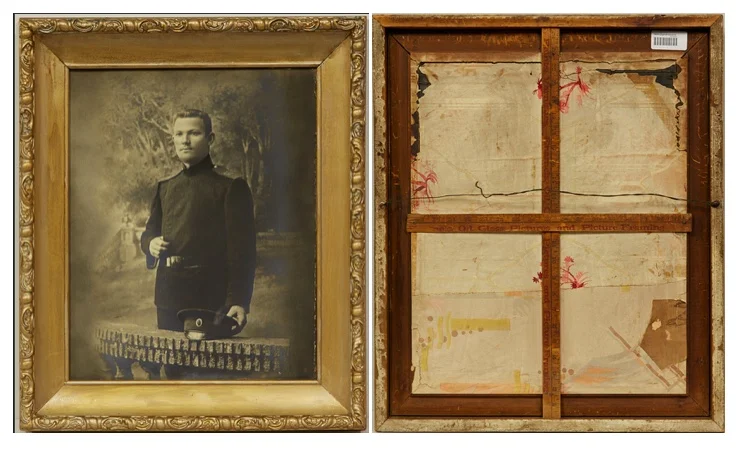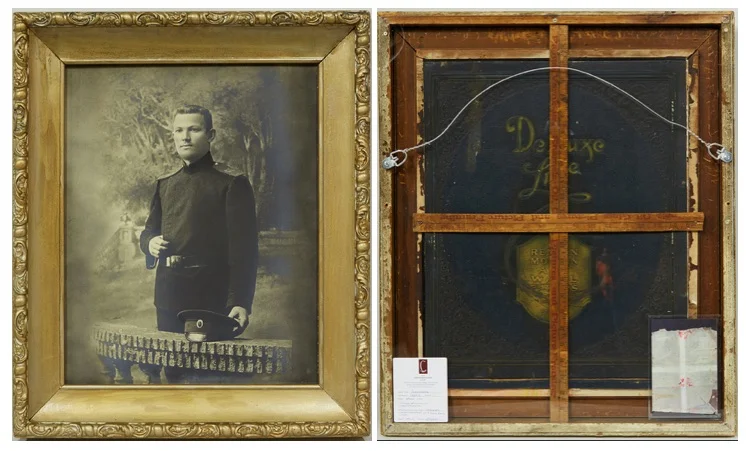“This is an important piece of our family history,” commented Cindy Egoroff Alexander while discussing a portrait of her grandfather, Emil Egoroff. Cindy and her family recently entrusted The Conservation Center to treat and reframe a black and white photograph of Emil. “We know very little of our grandfather’s life in Russia,” she explained, emphasizing how precious the few details they uncovered were to understanding and remembering her family’s past. Cindy graciously shared the history passed down through the family with our team, shedding light on the story behind this handsome portrait.
In December of 1913, Emil Egoroff, later joined by his wife and two children, traveled by boat from Bremen, Germany to Baltimore, Maryland. Fleeing Russia, where he was born in 1886 and served in Czar Nicholas II’s army, Emil and his family eventually found their way to Elgin, Illinois where he worked for a company called Svendsen & Co. before making a name for himself as a talented craftsman. As the self-effacing Emil and his family came to call Elgin home, he allowed his former life in Russia to fade into history. Only a photographic portrait of Emil in his military uniform offered a glimpse of his past.
Over the years, the portrait has been passed down through the Egoroff family. Once a decision was made to have it professionally assessed and possibly reframed, the family decided to bring it to The Conservation Center. As our team of conservators and framers reviewed the piece in its entirety they noticed the unorthodox materials from which the frame was constructed. It became clear that Emil had built the frame himself with the tools of his trade: wooden yardsticks and a wallpaper book cover. “Growing up,” Cindy recalled, “I remember seeing those yardsticks around his house all the time…and my grandfather showed his creative side by integrating those into the backing of the frame.”
The photograph inside was showing signs of aging. Curving slightly at the edges with some areas of loss around the perimeter, the photograph was beginning to peel. There was also a light layer of grime forming on the surface. The frame as well had a layer of particulates and some scratches requiring attention. The most significant issue with the framing was that the picture was in close contact with the glazing. Luckily, Cindy brought it to The Center before the photo became adhered to the glass.
Due to these discoveries, the conservation process became multifaceted, with the first segment focusing on the photograph itself. After a light surface cleaning to remove dust and grime, The Center’s digital restoration specialist scanned the portrait in high resolution. With a work measuring 16” x 20”, the scanning process was done in pieces and then digitally reassembled, to ensure as much detail was maintained as possible. Since the photograph was a silver gelatin print, some flares and reflections off the silver appeared while scanning, which had to be corrected. It was clear that in the past that some areas of the photo were reinforced by hand, so those areas were also digitally retouched. Prints of the image were requested by the client, so re-sizing and archival outputs were the next step. To finish off her contribution, our digital restoration specialist documented Cindy’s work in a multitude of formats, creating a CD as well as multiple 8” x 10” prints to be shared, so everyone could have access to this precious piece of family history.
After treating the photograph, the project moved to The Center’s custom framing department, which was tasked with putting the picture back into the frame in a manner that protected it from future damage. After mounting and assembling, Tru Vue Conservation Clear glass—which offers 99% UV protection—was applied to further protect the photograph from the damaging effects of the sun and other light sources. In addition, spacers were added to make sure the photo would not come into contact with the glazing. To maintain the integrity of the work, the piece was re-installed in to its original frame, and for additional support, an acrylic backing board was attached, providing protection for the wonderful handiwork and craftsmanship of Emil as well as supporting the work as a whole.
Both the photograph and his handmade yardstick strainer provide a portrait of the man—his image and his legacy preserved for years to come. “My sisters and I are thrilled with The Conservation Center’s treatment of our grandfather’s portrait,” Cindy Egoroff Alexander said. “I knew it was in good hands from the beginning, and the results were even better than originally expected."








